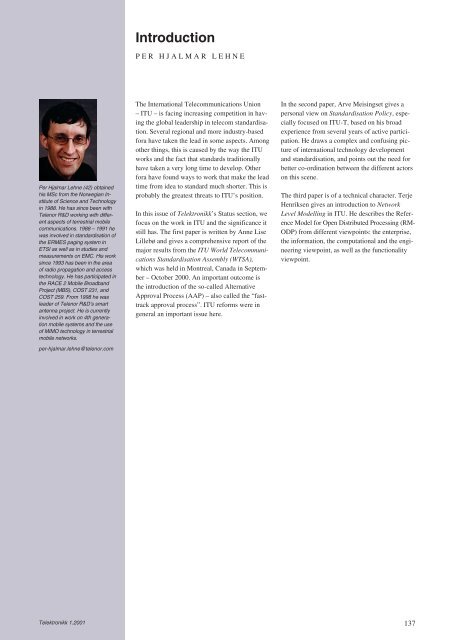Create successful ePaper yourself
Turn your PDF publications into a flip-book with our unique Google optimized e-Paper software.
Per Hjalmar Lehne (42) obtained<br />
his MSc from the Norwegian Institute<br />
of Science and Technology<br />
in 1988. He has since been with<br />
<strong>Telenor</strong> R&D working with different<br />
aspects of terrestrial mobile<br />
communications. 1988 – 1991 he<br />
was involved in standardisation of<br />
the ERMES paging system in<br />
ETSI as well as in studies and<br />
measurements on EMC. His work<br />
since 1993 has been in the area<br />
of radio propagation and access<br />
technology. He has participated in<br />
the RACE 2 Mobile Broadband<br />
Project (MBS), COST 231, and<br />
COST 259. From 1998 he was<br />
leader of <strong>Telenor</strong> R&D’s smart<br />
antenna project. He is currently<br />
involved in work on 4th generation<br />
mobile systems and the use<br />
of MIMO technology in terrestrial<br />
mobile networks.<br />
per-hjalmar.lehne@telenor.com<br />
Telektronikk 1.2001<br />
Introduction<br />
PER HJALMAR LEHNE<br />
The International Telecommunications Union<br />
– ITU – is facing increasing competition in having<br />
the global leadership in telecom standardisation.<br />
Several regional and more industry-based<br />
fora have taken the lead in some aspects. Among<br />
other things, this is caused by the way the ITU<br />
works and the fact that standards traditionally<br />
have taken a very long time to develop. Other<br />
fora have found ways to work that make the lead<br />
time from idea to standard much shorter. This is<br />
probably the greatest threats to ITU’s position.<br />
In this issue of Telektronikk’s Status section, we<br />
focus on the work in ITU and the significance it<br />
still has. The first paper is written by Anne Lise<br />
Lillebø and gives a comprehensive report of the<br />
major results from the ITU World Telecommunications<br />
Standardisation Assembly (WTSA),<br />
which was held in Montreal, Canada in September<br />
– October 2000. An important outcome is<br />
the introduction of the so-called Alternative<br />
Approval Process (AAP) – also called the “fasttrack<br />
approval process”. ITU reforms were in<br />
general an important issue here.<br />
In the second paper, Arve Meisingset gives a<br />
personal view on Standardisation Policy, especially<br />
focused on ITU-T, based on his broad<br />
experience from several years of active participation.<br />
He draws a complex and confusing picture<br />
of international technology development<br />
and standardisation, and points out the need for<br />
better co-ordination between the different actors<br />
on this scene.<br />
The third paper is of a technical character. Terje<br />
Henriksen gives an introduction to Network<br />
Level Modelling in ITU. He describes the Reference<br />
Model for Open Distributed Processing (RM-<br />
ODP) from different viewpoints: the enterprise,<br />
the information, the computational and the engineering<br />
viewpoint, as well as the functionality<br />
viewpoint.<br />
137

















